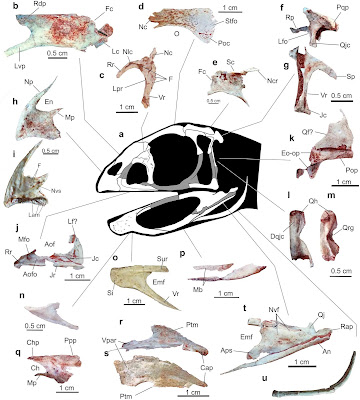Abstract
The recognition of ontogenetic edentulism in the Jurassic noasaurid Limusaurus inextricabilis shed new light on the dietary diversity within Ceratosauria, a stem lineage of non-avian theropod dinosaurs known for peculiar craniomandibular adaptations. Until now, edentulism in Ceratosauria was exclusive to adult individuals of Limusaurus. Here, an exceptionally complete skeleton of a new toothless ceratosaur, Berthasaura leopoldinae gen. et sp. nov., is described from the Cretaceous aeolian sandstones of the Bauru Basin, Southern Brazil. The specimen resembles adult individuals of Limusaurus by the absence of teeth but based on the unfused condition of several elements (e.g., skull, vertebral column) it clearly represents an ontogenetically immature individual, indicating that it might never have had teeth. The phylogenetic analysis performed here has nested Berthasaura leopoldinae as an early-divergent Noasauridae, not closely related to Limusaurus. It represents the most complete non-avian theropod from the Brazilian Cretaceous and preserves the most complete noasaurid axial series known so far. Moreover, the new taxon exhibits many novel osteological features, uncommon in non-avian theropods, and unprecedented even among South American ceratosaurs. These include not only toothless jaws but also a premaxilla with cutting occlusal edge, and a slightly downturned rostral tip. This indicate that B. leopoldinae unlikely had the same diet as other ceratosaurs, most being regarded as carnivorous. As the ontogenetically more mature specimens of Limusaurus, Berthasaura might have been herbivorous or at least omnivorous, corroborating with an early evolutionary divergence of noasaurids from the ceratosaurian bauplan by disparate feeding modes.
 |
| Berthasaura leopoldinae gen. et sp. nov., holotype (MN 7821-V), nearly complete skeleton. (a) Photograph. (b) Respective line drawing. |
 |
| Interpretative line drawing of Berthasaura leopoldinae gen. et sp. nov., holotype (MN 7821-V), and photographs. (a) Line drawing reconstruction |
 |
| Berthasaura leopoldinae gen. et sp. nov. holotype (MN 7821-V), interpretative line drawing of the skull and photographs of cranial bones. (a) Interpretative reconstruction of the skull. |
Systematic paleontology
Dinosauria Owen, 1842
Theropoda Marsh, 1881
Abelisauroidea (Bonaparte and Novas, 1985) sensu Wilson et al.13
Noasauridae Bonaparte & Powell, 1980 sensu Wilson et al.13
Berthasaura leopoldinae gen. et sp. nov.
Holotype: MN 7821-V comprises a nearly complete disarticulated skeleton, including a partial skull and lower jaw
Horizon and locality: Cemitério dos Pterossauros Quarry, Goio Erê Formation, Early Cretaceous (Aptian-Albian), Caiuá Group, Bauru Basin. The fossils were collected in layers that crop out in a rural road at Cruzeiro do Oeste Municipality, Paraná State, Southern Brazil.
Diagnosis: Noasaurid ceratosaur with the following combination of characters that distinguishes it from other members of the clade (autapomorphies are marked with an asterisk): edentulous rostrum (premaxilla, maxilla and dentary); lamellae on the medial surface of the premaxilla*; short dentaries with the length rostral to the mandibular fenestra about 1.5 times the height of the dentary*; protuberance projecting from the caudoventral end of the premaxillary buccal rim*; non-bifurcated rostral end of splenial*; postzygodiapophyseal lamina in mid-cervical vertebrae divided in two parts and reduced to low ridges; maximal length of metacarpus less than 15% of the length of humerus; iliac blade mediolaterally flattened; medial brevis shelf strongly reduced*; deep notch on the caudal margin of the ischial process producing an eminent and caudally-oriented prong*; rounded medial femoral epicondyle.
Etymology: The generic name honors the researcher Bertha Maria Júlia Lutz (1894–1976) for her scientific contribution and social activity particularly regarding woman rights in Brazil, combined with saura, feminine of saurus from the Greek for lizard. The specific epithet leopoldinae honors the first Brazilian empress, Maria Leopoldina (1797–1826), for her fundamental role in the independency of Brazil that next year (2022) will complete two centuries; and the samba school Imperatriz Leopoldinense, that in the 2018 carnival developed the theme "A Royal Night at the Museu Nacional" (Uma noite real no Museu Nacional) in commemoration of the bicentenary of the museum. This was before the large fire of September 2018.
 |
| Life reconstruction of Berthasaura leopoldinae gen. et sp. nov. in the paleoenvironment represented by the “Cemitério dos Pterossauros” Quarry. |
Geovane Alves de Souza, Marina Bento Soares, Luiz Carlos Weinschütz, Everton Wilner, Ricardo Tadeu Lopes, Olga Maria Oliveira de Araújo and Alexander Wilhelm Armin Kellner. 2021. The First edentulous Ceratosaur from South America. Scientific Reports. 11, 22281. DOI: 10.1038/s41598-021-01312-4



